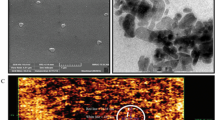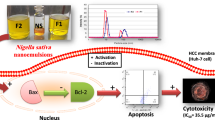Abstract
This study was done to improve the medicinal properties of Syzygium Aromaticum L by processing S. Aromaticum L. bud essential oil (SABE) to the Nanoemulsion drug delivery system (SABE-NE) and investigating its anti-tumor and apoptotic impacts against the human HT-29 colon cancer cells. Applying the ultra-sonication method and characterization by DLS and FESEM analysis facilitates the nanoemulsification procedure. Human cancer (HT-29) and normal (HFF) cell lines were then evaluated based on the SABE-NE apoptotic and cytotoxic effects. In an in vitro section, flow cytometry method, Cas3 gene profile, AO/PI cell staining, and MTT assays are used to analyze the apoptotic and cytotoxic activities. In further analysis, liver lipid peroxidation and antioxidant genes expression (SOD, CAT, and GPx) investigate alterations in mice organs. As a result, produced 131.2 nm SABE-NE induces apoptosis response and cellular death (Cas3 up-regulation and enhanced SubG1 peaks). Subsequently, the HT-29 cells' viability can reduce significantly, while HFF cells indicate confined cytotoxic impacts. Moreover, in vivo test results on mice livers demonstrate the cytoprotective properties of SABE-NE (reduced lipid peroxidation and increased antioxidant enzymes gene expression and nondetectable cytotoxic impacts). We produced a novel nanoemulsion drug delivery system called SABE-NE, a cell-specific apoptotic inducer. We thus can be utilized as an efficient anti-cancer compound for human colon cancer treatment. However, further supplementary studies are required to verify and approve its cell-specific anti-tumor activity.






Similar content being viewed by others
Data availability
The datasets applied during the current study are available on reasonable request.
References
Ahmad N, Alam MA, Ahmad FJ, Sarafroz M, Ansari K, Sharma S, Amir M (2018) Ultrasonication techniques used for the preparation of novel eugenol-nanoemulsion in the treatment of wounds healings and anti-inflammatory. J Drug Deliv Sci Technol 46:461–473
Arnold M, Sierra MS, Laversanne M, Soerjomataram I, Jemal A, Bray F (2017) Global patterns and trends in colorectal cancer incidence and mortality. Gut 66(4):683–691. https://doi.org/10.1136/gutjnl-2015-310912
Assayag M, Rouvier P, Gauthier M, Costel G, Cluzel P, Mercadal L, Deray G, Bagnis CI (2017) Renal failure during chemotherapy: renal biopsy for assessing subacute nephrotoxicity of pemetrexed. BMC Cancer 17(1):1–8
Atsumi T, Murakami Y, Shibuya K, Tonosaki K, Fujisawa S (2005) Induction of cytotoxicity and apoptosis and inhibition of cyclooxygenase-2 gene expression, by curcumin and its analog, α-diisoeugenol. Anticancer Res 25(6B):4029–4036
Banerjee S, Panda CK, Das S (2006) Clove (Syzygium aromaticum L), a potential chemopreventive agent for lung cancer. Carcinogenesis 27(8):1645–1654
Beyrami M, Karimi E, Oskoueian E (2020) Synthesized chrysin-loaded nanoliposomes improves cadmium-induced toxicity in mice. Environ Sci Pollut Res 27(32):40643–40651
Bou DD, Lago JHG, Figueiredo CR, Matsuo AL, Guadagnin RC, Soares MG, Sartorelli P (2013) Chemical composition and cytotoxicity evaluation of essential oil from leaves of Casearia sylvestris, its main compound α-zingiberene and derivatives. Molecules 18(8):9477–9487
Bozzuto G, Molinari A (2015) Liposomes as nanomedical devices. Int J Nanomed 10:975–999. https://doi.org/10.2147/ijn.s68861
Chaieb K, Hajlaoui H, Zmantar T, Kahla-Nakbi AB, Rouabhia M, Mahdouani K, Bakhrouf A (2007) The chemical composition and biological activity of clove essential oil, Eugenia caryophyllata (Syzigium aromaticum L Myrtaceae): a short review. Phytother Res 21(6):501–506
Constantinides PP, Chaubal MV, Shorr R (2008) Advances in lipid nanodispersions for parenteral drug delivery and targeting. Adv Drug Deliv Rev 60(6):757–767
Date AA, Desai N, Dixit R, Nagarsenker M (2010) Self-nanoemulsifying drug delivery systems: formulation insights, applications and advances. Nanomedicine 5(10):1595–1616
Dawane JS, Pandit VA (2012) Understanding redox homeostasis and its role in cancer. J Clin Diagn Res JCDR 6(10):1796
Donsì F, Annunziata M, Sessa M, Ferrari G (2011) Nanoencapsulation of essential oils to enhance their antimicrobial activity in foods. LWT-Food Sci Technol 44(9):1908–1914
Dwivedi V, Shrivastava R, Hussain S, Ganguly C, Bharadwaj M (2011) Comparative anticancer potential of clove (Syzygium aromaticum)—an Indian spice—against cancer cell lines of various anatomical origin. Asian Pac J Cancer Prev 12(8):1989–1993
Erlejman A, Verstraeten S, Fraga C, Oteiza P (2004) The interaction of flavonoids with membranes: potential determinant of flavonoid antioxidant effects. Free Radical Res 38(12):1311–1320
Farshi P, Tabibiazar M, Ghorbani M, Hamishehkar H (2017) Evaluation of antioxidant activity and cytotoxicity of cumin seed oil nanoemulsion stabilized by sodium caseinate-guar gum. Pharmaceutical Sci 23(4):293–300
Ghosh R, Nadiminty N, Fitzpatrick JE, Alworth WL, Slaga TJ, Kumar AP (2005) Eugenol causes melanoma growth suppression through inhibition of E2F1 transcriptional activity. J Biol Chem 280(7):5812–5819
Hosseini A, Ghorbani A (2015) Cancer therapy with phytochemicals: evidence from clinical studies. Avicenna J Phytomed 5(2):84
Jaganathan SK, Mazumdar A, Mondhe D, Mandal M (2011) Apoptotic effect of eugenol in human colon cancer cell lines. Cell Biol Int 35(6):607–615
Jaiswal M, Dudhe R, Sharma P (2015) Nanoemulsion: an advanced mode of drug delivery system. 3 Biotech 5(2):123–127
Jaradat NA, Zaid AN, Abuzant A, Shawahna R (2016) Investigation the efficiency of various methods of volatile oil extraction from Trichodesma africanum and their impact on the antioxidant and antimicrobial activities. J Intercult Ethnopharmacol 5(3):250
Khan I, Bahuguna A, Kumar P, Bajpai VK, Kang SC (2018) In vitro and in vivo antitumor potential of carvacrol nanoemulsion against human lung adenocarcinoma A549 cells via mitochondrial mediated apoptosis. Sci Rep 8(1):1–15
Kim GC, Choi DS, Lim JS, Jeong HC, Kim IR, Lee MH, Park BS (2006) Caspases-dependent apoptosis in human melanoma cell by eugenol. Korean J Anat 39(3):245–253
Lesgards JF, Baldovini N, Vidal N, Pietri S (2014) Anticancer activities of essential oils constituents and synergy with conventional therapies: a review. Phytother Res 28(10):1423–1446
Mahato R (2017) Nanoemulsion as targeted drug delivery system for cancer therapeutics. J Pharm Sci Pharmacol 3(2):83–97
Mahdi Jafari S, He Y, Bhandari B (2006) Nano-emulsion production by sonication and microfluidization—a comparison. Int J Food Prop 9(3):475–485
Navaei Shoorvarzi S, Shahraki F, Shafaei N, Karimi E, Oskoueian E (2020) Citrus aurantium L bloom essential oil nanoemulsion: synthesis, characterization, cytotoxicity, and its potential health impacts on mice. J Food Biochem 44(5):e13181
Paim LFNA, Dalla Lana DF, Giaretta M, Danielli LJ, Fuentefria AM, Apel MA, Külkamp-Guerreiro IC (2018) Poiretia latifolia essential oil as a promising antifungal and anti-inflammatory agent: chemical composition, biological screening, and development of a nanoemulsion formulation. Ind Crops Prod 126:280–286
Rao PV, Nallappan D, Madhavi K, Rahman S, Jun Wei L, Gan SH (2016) Phytochemicals and biogenic metallic nanoparticles as anticancer agents. Oxid Med Cell Longev 2016:1–15
Rossi J, Leroux J, Wasan K (2006) Role of lipid excipients in modifying oral and parenteral drug delivery. Wiley, Hoboken
Sarker DK (2005) Engineering of nanoemulsions for drug delivery. Curr Drug Deliv 2(4):297–310
Shan B, Cai YZ, Sun M, Corke H (2005) Antioxidant capacity of 26 spice extracts and characterization of their phenolic constituents. J Agric Food Chem 53(20):7749–7759
Sharma N, Bansal M, Visht S, Sharma P, Kulkarni G (2010) Nanoemulsion: a new concept of delivery system. Chron Young Sci 1(2):2
Solans C, Izquierdo P, Nolla J, Azemar N, Garcia-Celma MJ (2005) Nano-emulsions. Curr Opin Colloid Interface Sci 10(3–4):102–110
Sznarkowska A, Kostecka A, Meller K, Bielawski KP (2017) Inhibition of cancer antioxidant defense by natural compounds. Oncotarget 8(9):15996
University of Zagreb. MEASUREMENT AND APPLICATION OF ZETA-POTENTIAL. https://hrcak.srce.hr/24757 (1992)
Yousefzadi M, Riahi-Madvar A, Hadian J, Rezaee F, Rafiee R, Biniaz M (2014) Toxicity of essential oil of Satureja khuzistanica: in vitro cytotoxicity and anti-microbial activity. J Immunotoxicol 11(1):50–55
Funding
There has been no financial support for this work.
Author information
Authors and Affiliations
Corresponding author
Ethics declarations
Conflict of interest
The authors declare that they have no competing interests.
Rights and permissions
About this article
Cite this article
Abadi, A.V.M., Karimi, E., Oskoueian, E. et al. Chemical investigation and screening of anti-cancer potential of Syzygium aromaticum L. bud (clove) essential oil nanoemulsion. 3 Biotech 12, 49 (2022). https://doi.org/10.1007/s13205-022-03117-2
Received:
Accepted:
Published:
DOI: https://doi.org/10.1007/s13205-022-03117-2




